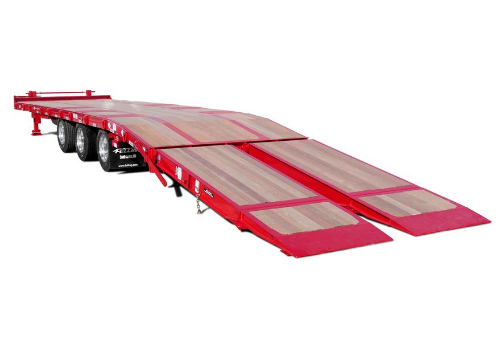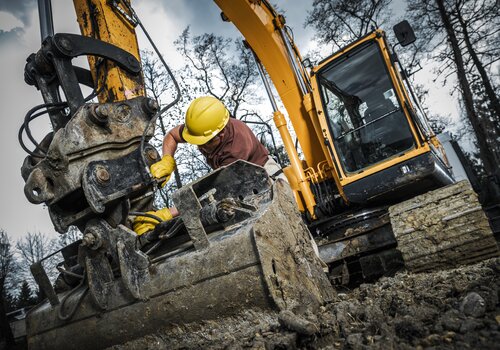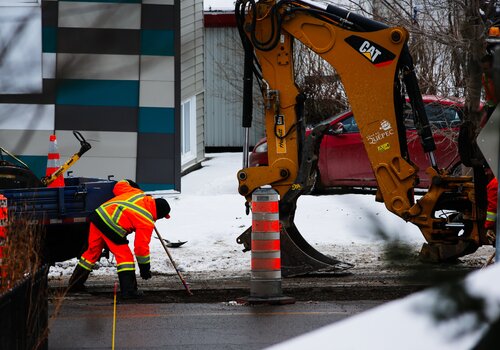When it comes to selecting a trailer to haul your heavy construction equipment, you have more than a few options to consider. And when your trailers are carrying a variety of machines to and from the jobsite it only gets more complex. To make the process less daunting, we asked the experts from three trailer manufacturers to discuss the most important considerations.
Find the Right Size Trailer
Matching the capacity of the trailer to the weight of the equipment you want to haul is key. “Buying too small is unsafe, buying too much capacity is a waste of money,” says Jim Ladner, national sales manager for Landoll Company, Transportation Products division. “A good decision now is a great ROI on the selling side.”
But it’s not just the trailer you need to consider. “It’s imperative that both the trailer and the tow vehicle are appropriately sized to carry the load,” says Nathan Uphus, sales manager, Felling Trailers. Also don’t forget to consider the weight of attachments you plan to haul along with the machine. Uphus says attachments are often overlooked.
“Most excavators have a travel mode that narrows the width of the machine,” says Troy Geisler, vice president of sales and marketing for Talbert Trailers. “However, some operators will not go to the trouble that it takes to put the machine in travel mode. You have to know how your operators will actually load the machine or you could stress the trailer.”
Geisler cautions that buyers need to beware when comparing load capacity. “There is no standard method to determine a capacity rating, “says Geisler. “Some manufacturer ratings may be based on an impractical load distribution.”
A 35- to 65-ton capacity trailer is needed to carry most mid-size or large construction equipment. A 55- to 65-ton capacity trailer is typically needed for transporting larger cranes and specialty equipment.
Know Where Are You Going to Haul Your Equipment
Regulations change from state to state so it’s important to consider where you want to travel. “You want to make sure you have the right trailer capacity, the correct number of axles and the axles are positioned in the correct locations,” says Ladner.
Can One Trailer Do It All?
“It’s common for users to want to buy a single trailer that hauls all their equipment, but in most cases that’s not possible, says Ladner. ““Users should consider selecting a trailer that accomplishes 80 percent of their moves and sub-contract the highly specialized loads to an outside hauler.”
Ladner says the more pieces of equipment you can transport in a single move the more you will reduce hauling costs. He advises operators to look for more useable deck space to accommodate a wide variety of equipment.
 Trailer Types 101
Trailer Types 101
Different trailer designs offer varying benefits for transporting heavy construction equipment.
Lowboy, low bed trailers or float trailers (Eastern Canada) feature two drops in deck height: one right after the gooseneck and one prior to the wheels. It’s designed to keep the heavy haul load as low as possible – 18 inches off the ground. If you are worried about maximizing vertical clearance to safely transport equipment, this can be a good option. “The lower the better” really plays true to help reduce the chances of rollovers accidents,” says Ladner.
Gooseneck trailers have a 'neck' that extends over the box or bed of the tow vehicle. A ball hitch is placed into the box of the truck.” The design offers greater stability because weight is centered on the rear axle of the truck rather than the rear bumper.
A drop deck trailer, is an open trailer with two deck levels: an upper deck and a lower deck that drops down after clearing the tractor unit. Equipment is typically loaded using fold down ramps. According to Geisler, these types of trailers are useful for hauling compact construction equipment.
With tilt trailers there is no need for a ramp to load and unload equipment. However, some equipment, such as pavers require a very shallow load angle, so ramps are sometimes added. The axles are further forward on the tilt trailer compared to a beavertail trailer (with ramps). This allows the trailer to tilt without hitting the tires and also improves maneuverability. Hydraulic tilt models generally have a stationary platform ahead of the tilt deck. The stationary platform remains flat while the tilt deck allows the machine to be loaded/unloaded.
On sliding or traveling axle trailers the axle travels forward, allowing the tail of the trailer to lower to the ground. This creates a “ramp” to load equipment on and delivers a load angle of six degrees. Don Landoll, owner and chairman of Landoll Company, invented and patented the Traveling Axle trailer in 1969.
New Trailers Deliver
“Equipment keeps getting bigger, wider, taller and heavier,” says Geisler. “We react and adjust so we better understand the ever-changing needs of customers.” Talbert recently introduced the 35FG-BVTL, a fixed-neck, drop deck trailer for small- to mid-size equipment machinery movers operating in oil fields, agriculture, construction and demolition.
Felling Trailers is using common air supplied by the tow vehicle to power ramps. Recently introduced Air Operated Bi-Fold ramps provide a very shallow load angle useful for loading and unloading paving equipment. The ramps are featured on the FT-50-3 LP Low Profile Tag, 25-ton load capacity trailer.
Landoll introduced some new advanced options on detachable trailers including seven different ride height settings on the 800 series Detachable trailer line. A full width, low-angle loading ramp is suitable for a wide range of equipment including pavers, rollers, planners and forklifts.
Once you have a good understanding of your needs, reach out to your dealer representatives, who can help you find the right trailer for your situation. Like any other equipment investment, trailers need to deliver on every level.
Trailers featured in this article:
Join over 40,000 industry peers who receive construction industry news and trends each week. Subscribe to CONEXPO-CON/AGG 365.












